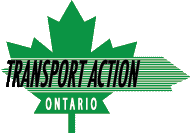Transport Action Ontario featured in article on road tolls
By Transport Action Ontario | Highways and Bridges , Latest News , Urban Transit
Note to Readers: with the approval of expressway tolls in Toronto, interest in road tolling has spiked all across the Greater Toronto and Hamilton Area. Transport Action Ontario was featured in an article by York Region Media Group on this topic. The article summarizes our position and reasons why we support such tolls. The article can be viewed below.
Transportation group advocates for toll roads in York Region
If you’re a commuter who thinks toll roads coming to Toronto are highway robbery, brace yourself.
While the issue doesn’t have the same traction as it does in Toronto where council agreed in December to pursue the idea, it is slowly percolating, mainly out of the public eye, in York Region.
“We’ve been working behind the scenes (to make it happen here),” said Markham resident Peter Miasek, past-president of Transport Action Ontario, an organization advocating for rail-based public transportation.
The organization supports tolls on highways 400 and 404, with revenues being earmarked for transit and transportation projects in the region.
The organization has talked about toll roads with regional transportation staff and some councillors, including Newmarket Coun. John Taylor and Richmond Hill Coun. Vito Spatafora, who chairs the region’s transportation committee, Miasek said.
“Support and participate in a constructive dialogue on road pricing among governments, the business sector and general public across the GTHA (Greater Toronto and Hamilton Area) and support education, research and demonstration that are essential to effective, efficient and equitable road pricing in the long term,” the plan said.
Miasek, who made a presentation to Toronto’s executive committee on Dec. 1 in favour of the city’s plan to impose tolls on the Gardiner Expressway and Don Valley Parkway, said it doesn’t make sense to bring toll roads to York Region until the transit system is at a point where it can offer a reliable alternative to driving.
But with significantly expanded GO train service now being implemented, it makes sense to start discussing the issue, he said.
Toll roads have many benefits, Miasek said.
“It does a number of things. It boosts revenue, it will cut travel time for those people who want to pay, it does wean us off the car,” he said, adding a program to help low-income commuters could be considered.
“I do think our automobiles, and I’m an auto driver like everyone else up here, is past its best before date with all the accidents and the health issues, climate change, congestion and all of that. So, it’s a step in the right direction.”
While Toronto is eyeing a $2 flat toll, Miasek said a fee by distance is fairer and would also help prevent drivers from bailing from the highway onto local roads just before tolls begin.
Ideally, the province would be leading the discussion but likely won’t embrace the political hot potato in advance of the 2018 election, Miasek said.
He acknowledged the issue is controversial.
“I may not want to run for most beloved citizen,” he laughed, adding he’s surprised at the support he’s heard among his friends for toll roads as long as rates are reasonable and the revenues are used to improve transit and transportation infrastructure.
Spatafora, who agreed the region is looking at the concept of road pricing, said he has mixed feelings about toll roads.
Implementing tolls on highways 404 and 400 would be difficult because they are provincial highways but the region could consider them for future regional roads, specifically much-needed and expensive east-west streets needed to ease the region’s serious traffic congestion problems, Spatafora said.
Tolls are worth considering if the revenues are used for the construction of transit and transportation infrastructure, not to fund ongoing operating expenses, Spatafora said.
It’s also crucial they not be run like Highway 407, he said.
“I take a look at what’s happened with Highway 407 and it’s become a money-maker for foreign investors. It kind of defeats the purpose because a lot of people who’d want to use this east-west connection avoid it because of the heavy cost,” he said.
“If it’s a reasonable cost, in terms of the operating expense, then it’s one thing. But when it becomes a gouge, like it has been with the 407, that’s where I’m hesitant and have concerns.”
Tolls shouldn’t be implemented until the region’s transit system is more developed, Spatafora said.
Tolls can cause drivers to migrate to surrounding non-toll roads, meaning traffic patterns are just shifted rather than alleviated, Elliott Silverstein, manager of government relations in the Canadian Automobile Association’s Thornhill office, said.
The CAA and Conference Board of Canada produced a report in 2010 which showed motorists in Ontario pay for 70 to 80 per cent of road infrastructure costs through fuel taxes and vehicle registration fees.
That jumps to “well over 100 per cent” in the GTHA, showing motorists already shoulder more than their fair share of transportation costs, Silverstein said.
On Jan. 1, drivers will begin paying 4.3 cents more in gas taxes as part of the carbon tax, putting more of a burden on motorists, he said.
Governments need to look at other options other than tolls to manage traffic congestion, Silverstein said.


